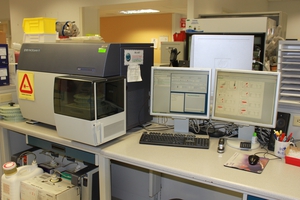Hematology
 BD FACSanto II Flow Cytometry Analyzer
血液学是研究、诊断、治疗和预防与血液有关的疾病的医学分支。它涉及治疗影响血液及其成分(如血细胞、血红蛋白、血液蛋白质和凝血机制)生产的疾病。
BD FACSanto II Flow Cytometry Analyzer
血液学是研究、诊断、治疗和预防与血液有关的疾病的医学分支。它涉及治疗影响血液及其成分(如血细胞、血红蛋白、血液蛋白质和凝血机制)生产的疾病。
Some examples of tests performed in the hematology department at the OSF HealthCare Saint Francis Medical Center Laboratory include:
- Complete Blood Count:A count of the total number of red blood cells, white blood cells and platelets present in blood, as well as calculations of parameters associated with them.
- Erythrocyte sedimentation rate (ESR):在一小时内红细胞沉淀速率的测量
- Reticulocyte count:Percentage of immature red blood cells which can help diagnose anemias, and determine the effectiveness of treatments.
- Cerebrospinal fluid cell count and differential: Detection of Meningitis, Encephalitis, Multiple Sclerosis, hemorrhage, abscess, tumor, and other infections.
- Screening for sickle-cell disease:Inherited trait that affects 8% of African-Americans, where red blood cells are “C” shaped and rigid, vs circular and flexible.
- Flow Cytometry:A specialized department that uses a laser based, biophysical technology to diagnose blood, tissue and bone marrow disorders.
Coagulation Testing
Coagulation tests measure the ability of blood to clot, as well as how long it takes. They are usually ordered when someone is experiencing abnormal bleeding or bruising. Testing can assess the risk of excessive bleeding or the formation of clots (thrombosis) somewhere in the blood vessels.
Prothrombin time (PT), International Normalized Ratio (INR), Activated Partial Thromboplastin Time (aPTT), andThrombin Time (TT)tests are sometimes ordered before a patient undergoes surgery or to check medication levels, such as in patients who are on anticoagulant drugs.D-dimersare ordered to check for thrombotic activity and disorders by measuring a small protein fragment of a degraded blood clot.
Routine Coag Tests Performed
| Test Name | Frequency performed | OSF TAT |
|---|---|---|
| Prothrombin Time w/ INR | Daily | < 1 day* |
| Prothrombin Time Mixing Studies | M-F AM shift | 1-2 days |
| Activated Partial Thromboplastin Time | Daily | < 1 day* |
| Activated Partial Thromboplastin Time Mixing Studies | M-F AM shift | 1-2 days |
| Circulating PTT Inhibitor | M-F AM shift | 1-2 days |
| Fibrinogen | Daily | < 1 day* |
| Thrombin Time | M-F AM shift | 1-2 days |
| Platelet Function Assay | Daily | < 1 day* |
| Coagulation Profile (PT, PTT, Fibrinogen) | Daily | < 1 day* |
| D-Dimer (Quantitative) | Daily | < 1 day* |
| Coagulation Profile w/ D-Dimer | Daily | < 1 day* |
| Protein C Activity | M-F AM shift | 1-2 days |
| Protein S Activity | M-F AM shift | 1-2 days |
| Antithrombin 3, Functional | Daily | 1 day |
| Lupus Anticoagulant Screen (Dilute Russell Viper Venom Test) | M-F AM shift | 2 days |
| Heparin Dependent Antibody Screen (PF4IgG) | M-F AM shift | 1 day |
| Low Molecular Weight Heparin Assay (Anti XA) | Daily | 1 day |
*< 1 day TAT for a local client means tests are generally resulted in a matter of hours, including transport time.
Factor Activity
Factor activitymay be measured when someone is suspected of having an acquired condition that is causing bleeding, such as vitamin K deficiency or liver disease. Sometimes factor testing may be done on a person with a known deficiency to monitor the factor deficiency and to evaluate the effectiveness of treatment. A few of the Factor assays performed routinely are:
Routine Factor Assays Performed
| Test Name | Frequency performed | OSF TAT |
|---|---|---|
| Factor II Activity | M-F AM shift | 1 day |
| Factor IX Activity | M-F AM shift | 1 day |
| Factor IX Inhibitor | M-F AM shift | 1-2 days |
| Factor V Activity | M-F AM shift | 1 day |
| Factor V Leiden Screen Activated Protein C Resistance | M-F AM shift | 2-3 days |
| Factor VII Activity | M-F AM shift | 1 day |
| Factor VIII Activity | M-F AM shift | 1 day |
| Factor VIII Inhibitor | M-F AM shift | 1-2 days |
| Factor X Activity (not anti-XA) | M-F AM shift | 1 day |
| Factor XI Activity | M-F AM shift | 1 day |
| Factor XII Activity | M-F AM shift | 1 day |
| Von Willebrand Factor Antigen | M-F AM shift | 1 day |
Many clinical conditions can lead to unexplained bleeding and can be tested for as well. Some examples are:
- Congenital hemophilia -这种典型的出血障碍是一种x连锁隐性遗传异常。只有一份缺陷的雄性会受到影响;然而,女性是无症状携带者。该疾病源于凝血级联中的两种改变蛋白之一,因子VIII(血友病A)或因子IX(血友病B),这两种蛋白在临床上无法区分。
- Von Willebrand Disease -Defective synthesis or release of functional Von Willebrand Factor (VWF) causes defective platelet adhesion and leads to a spectrum of conditions, such as epistaxis, heavy menstrual bleeding, and easy bruising.
- Antiphospholipid syndrome -An autoimmune prothrombotic acquired condition, Antiphospholipid Syndrome (APLS) is frequently associated with a markedly prolonged aPTT, leading to a concern that the affected individual might be at risk for a major hemorrhage. Not only is this highly unlikely, but as a prothrombotic state, APLS is typically associated with venous thromboembolism and/or arterial thrombosis.
- Acquired hemophilia -Although rare, acquired hemophilia results from spontaneous formation of autoantibodies to Factor VIII in a previously healthy individual, either male or female. As the name suggests, there is no overt genetic component. Factor VIII activity is significantly decreased as a result of the autoantibodies, and severe and uncontrolled bleeding results.
